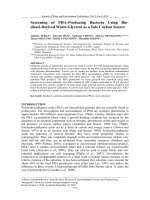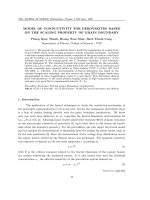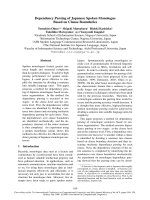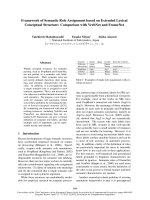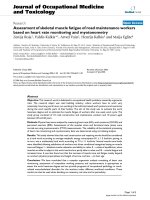Molecular identification of lipase producing bacteria based on 16S rDNA sequencing
Bạn đang xem bản rút gọn của tài liệu. Xem và tải ngay bản đầy đủ của tài liệu tại đây (92.43 KB, 5 trang )
Int.J.Curr.Microbiol.App.Sci (2017) 6(5): 2067-2071
International Journal of Current Microbiology and Applied Sciences
ISSN: 2319-7706 Volume 6 Number 5 (2017) pp. 2067-2071
Journal homepage:
Original Research Article
/>
Molecular Identification of Lipase Producing Bacteria based on
16S rDNA Sequencing
P. Pallavi*, P. Bhavani, J. Komali and T. Manjusha
Department of Microbiology, Government Degree College for Women, Nalgonda, India
*Corresponding author
ABSTRACT
Keywords
Molecular,
Lipases,
Deacetylation,
Isolation
Article Info
Accepted:
19 April 2017
Available Online:
10 May 2017
Lipases or triacyl glycerol acylester hydrolases or carboxyl esterases (E.C 3.1.1.3) that
catalyze both hydrolysis and synthesis of esters formed from glycerol. Lipases are
currently attracting an enormous attention because of their biotechnological applications.
In particular, lipases of microbial origin finding immense applications in various fields as
they can catalyze a variety of hydrolytic or synthetic reactions. A bacterial strain isolated
from an oil contaminated soil using Nutrient agar medium with 1% olive oil. The isolated
strains were screened for lipolytic activity on tributyrin agar and the lipolytic potential was
measured. The strains with lipolytic potential (R/r) >2 were selected and further screened
for lipase production on ideal medium. The Lipase assay was carried out by measuring the
growth using optical density at regular time intervals of 24hrs, 48hrs and 72hrs
respectively. The selected bacterial strain with maximum lipase production was observed
at 48hrs, 37oC (9.0 EU/ml). In our studies, the best producer of lipase was subjected to
molecular identification based on 16S r DNA nucleiotide sequence homology and
phylogenetic analysis, a newly isolated indigenous potential lipase producing strain (LP5)
was identified as Bacillus subtilis strain Y-IVI.
Introduction
Lipases (glycerol ester hydrolases, EC
3.1.1.3) are one of the most important classes
of industrial enzymes that catalyze the
hydrolysis of triglycerides to fatty acids and
glycerol (Jager and Reets, 1998; Rajendran
and Thangavelu, 2007). They are produced by
many bacteria, fungi, plants, animals and are
being employed in food, cosmetics, detergents
and pharmaceutical industries (Vulfson, 1994;
Suk- Jung et al., 2003). Recently, there have
been attempts to use lipase for the
deacetylation of cephalosporins (Lee et al.,
2001). Lipases are known to have certain
roles in human pathogenesis and their activity
modulators have been suggested as potent
pharmaceuticals for the treatment of obesity
(Kanwamura et al., 1999; Nonaka et al.,
1996; Park, 2001). Lipases perform essential
roles in the digestion, transport and
processing of dietary lipids (triglycerides,
fats, oils) in most living organisms.
Although the existence of lipolytic bacteria is
known for many years, our understanding of
bacterial lipolysis stems from the fact that
most of the studies are with crude enzyme
systems. Only few studies have been made
with partially purified lipases (Mencher et al.,
2067
Int.J.Curr.Microbiol.App.Sci (2017) 6(5): 2067-2071
1967). In view of the importance of bacterial
lipases, in the present investigations an
attempt was made to isolate, screen and
characterize efficient strains so that they can
be employed for commercial production.
Materials and Methods
Isolation
The oil contaminated soil samples were
collected aseptically and isolations were made
by spread plate method using serial dilutions
on nutrient agar medium amended with olive
oil as substrate. (composition: peptone 5g/l;
beef extract 3g/l; NaCl 5g/l; distilled water 1
liter; olive oil 1%) and the plates were
incubated at 30oC for 48 hours. The bacterial
colonies developed on the medium were
isolated and were selected for screening.
The selected strains were maintained on
nutrient agar medium amended with 1% olive
oil medium. Isolations were also made from
direct oil samples (ground nut oil, coconut oil,
palm oil etc.,) by taking 0.1ml of oil sample
and spreading it on to tributyrin agar plates.
Screening
The isolated strains were screened for
lipolytic activity and lipolytic potential (R/r),
using tributyrin agar medium and spirit blue
agar medium. The strains were spread on
tributyrin agar (Collins, 1964; Collins and
Lyne, 1980; Limpon et al., 2006) and spirit
blue agar medium and incubated for 24hours
at 30oC. Then, the bacterial colonies which
formed clear zone around them on the plates
were recorded and their lipolytic activity and
lipolytic potential was calculated by the
formula:
Lipolytic potential = hydrolytic zone diameter
/ colony diameter.
The strains which had exhibited high lipolytic
potential were selected and screened further
for efficient lipase production.
The strain was tested for lipase production
and assessed first in 25ml of enrichment
medium (peptone-10g/l, beef extract-3g/l,
NaCl-5g/l, 1% olive oil and pH-7). After
incubation for 24 hours the preculture formed
was inoculated into production medium (basal
medium) of composition (g/l): starch 20,
peptone 20, NH4Cl 3.8, MgSO4 1, K2HPO4
5, olive oil 1%, pH 7.0. The culture was then
incubated for 72 hours in an orbital shaker at
100 rpm at 30oC.The cells were then
harvested by centrifugation at 5000 rpm for
15min and the supernatant was used for
further assay at regular interval of 24 hours,
48 hours, and 72 hours. Bacterial growth was
determined by measuring the absorbance at
550 nm (Sangiliyandi and Gunasekaran,
1996) and the final pH of the medium was
also determined.
Lipase assay
The lipase activity in the culture filterate was
assayed by titrimetry (Venkateshwarlu and
Reddy, 1993). The reaction mixture included
2ml of enzyme, 5ml of citrate phosphate
buffer (pH 8.0), 2ml of triacetin and was
incubated at 37oC for 3hours, at the end of
incubation the reaction was terminated by
adding 10ml of ethanol and the mixture was
titrated against 0.05M NaOH using
phenolphthalein indicator. The activity of
enzyme was expressed in terms of enzyme
units. One unit of enzyme activity is defined
as the amount of enzyme required to liberate
1µmol of equivalent fatty acid (ml /min)
under the standard assay conditions.
16S rDNA sequence identification and
phylogenetic tree analysis
Genomic DNA extraction was utilized as a
template for the performance of PCR
2068
Int.J.Curr.Microbiol.App.Sci (2017) 6(5): 2067-2071
amplification for 16S rDNA identification
with a set of universal primers that are highly
conserved among prokaryotes and could
amplify 1,500bp. The universal primers used
were as follows: forward and reverse DNA
sequencing reaction of PCR amplicon was
carried out with 8F and 1492R primers
8F: 5' AGA GTT TGA TCC TGG CTC AG 3'
1492R: 5' ACG GCT ACC TTG TTA CGA
CTT 3' using BDT v3.1 cycle sequencing kit
on ABI 3730xl genetic analyzer. A DNA
homology search was conducted using the
Genbank
database
(http://WWW.
ncbi.nih.gov). A phylogenetic tree was
constructed using Tree Top phylogenetic Tree
prediction software (ebee.
msu.su).
Results and Discussion
In the present investigations, a large number
of bacterial strains were isolated from
different oil mill soils. Out of them, four
bacterial strains were selected for further
screening for their extra cellular enzymatic
activity. The lipolytic potential and hydrolytic
zone diameter were calculated on tributyrin
agar (Table 1). It is evident from the data
presented in the table that the highest lipolytic
activity was shown by Lp5and its lipolytic
potential is 2.6.
Data presented in table 2 and 3, reveals that
all the four strains of bacteria produced lipase
in one or other medium. Lp5 produced
maximum lipase (9.0Eu/ml) in medium, and
had highest growth of OD 0.651 at 48 hours
of incubation. All the other strains produced
lipase at optimum level at an incubation of 48
hours using the medium. The continuous
increasing in production was recorded till 48
hours and later the lipase production
decreased gradually so, for the above isolates
of bacterial strains lipase production was
optimum at 48 hours incubation on medium.
Table.1 Evaluation of lipolytic potential of selected strains
Isolate
Lp1
Lp3
Lp4
Lp5
Colony
diameter(r)mm
4.0
3.0
4.0
3.0
Zone diameter®
mm
6.0
8.0
8.0
8.0
Lipolytic
potential(R/r)
1.5
2.6
2.0
2.6
Table.2: Bacterial growth on Ideal medium
Isolate
Lp1
Lp3
Lp4
Lp5
24hr
0.193
0.429
0.249
0.375
Growth(OD)
48hr 72hr
0.527
0.682
0.651
0.506
0.563
0.663
0.603
0.712
2069
Int.J.Curr.Microbiol.App.Sci (2017) 6(5): 2067-2071
Fig.1 Phylogenetic tree showing evolutionary relationships of 11 taxa
10
2 0.0000000
0.0000000
1
11
0.0000000
0.0000000
0.0000000
0.0000000
0.0000000
0.0000000
1
12
0.0000000
0.0000000
0.0000000
0.0000000
10
0.0000000
FJ641007.1
GQ199597.1
FJ641015.1
GQ169813.1
FJ641016.1
FJ641014.1
0.0000000
11
0.0045984
GQ375227.1
0.0000000
0.0000000
0.0000000
GQ421472.1
GQ402829.1
GQ475486.1
0.0000000
LP5
0.0045984
BLAST DATA (Alignment view using combination of NCBI GenBank and RDP databases)
Alignment View
ID
Consensus
Alignment
Result
0.96
GQ475486.1
1.00
GQ421472.1
GQ402829.1
0.99
1.00
GQ375227.1
0.99
GQ199597.1
0.99
GQ169813.1
1.00
FJ641016.1
1.00
FJ641015.1
1.00
FJ641014.1
1.00
FJ641007.1
1.00
Description
Sample LP5 16S rDNA
Bacillus subtilis strain Y-IVI 16S ribosomal RNA
gene
Bacillus subtilis strain L4 16S ribosomal RNA gene
Bacillus sp. G3(2009) 16S ribosomal RNA gene
Bacillus subtilis subsp. subtilis strain CICC 10076
16S ribosomal RNA gene
Bacillus subtilis strain I527 16S ribosomal RNA gene
Bacillus subtilis strain B107 16S ribosomal RNA
gene
Bacillus subtilis strain IMAUB1036 16S
ribosomal RNA gene
Bacillus subtilis strain IMAUB1035 16S ribosomal
RNA gene
Bacillus subtilis strain IMAUB1031 16S ribosomal
RNA gene
Bacillus subtilis strain IMAUB1018 16S ribosomal
RNA gene
2070
Int.J.Curr.Microbiol.App.Sci (2017) 6(5): 2067-2071
Table.3: Production of lipase on ideal medium
Isolate
Lp1
Lp3
Lp4
Lp5
Eu/ml
24hr 48hr
2.0
6.0
1.6
6.4
3.2
5.0
5.5
9.0
16S rDNA identification and phylogenetic
tree analysis
Strain Lp5 was identified as Bacillus subtilis
strain Y-IVI sp. 16S ribosomal RNA was
employed for identification of the Lp5 strain.
The 16S rDNA nucleotide sequence obtained
for Lp5. The phylogenetic tree analysis of
Lp5 strain was constructed on the basis of
comparison of the 16S rDNA sequence of this
strain with other Bacillus sp. Strains available
in the NCBI Genebank database.
The phylogenetic tree analysis of strain Lp5
was compared with 10 other bacillus sp.
Sequences. It evidenced a high degree of
homology with Bacillus subtilis strain Y-IVI.
The phylogenetic relationship of closely
related Bacillus sp. Is depicted in fig. On the
basis of its morphological, cultural,
biochemical characteristics, 16S rDNA strain
Lp5 was identified as Bacillus subtilis strain
Y-IVI.
72hr
0.7
1.2
1.7
0.7
References
Jaeger, K.E. and Reetz, M.T. 1998. Microbial
lipases from versatile tools for
biotechnology. Trends in Biotechnol., 16:
369-403.
Mencher, J.R. and Alford, J.A. 1967.
Purification and characterization of the
lipase of Pseudomonas fragi. J. Gen.
Microbiol., 48: 317-328.
Collins, C.H. and Lyne, P.M. 1980.
Microbiological methods, 4th Edition
Butterworths, London.
Collins, C.H. 1964. Microbiological methods
Butterworths, London.
Sangiliyandi, G. and Gunasekaran, P. 1996.
Extracellular lipase producing Bacillus
licheniformis from an oil mill refinery
effluent. Ind. J. Microbiol., 36: 109-110.
Venkateshwarlu, N. and Reddy, S.M. 1993.
Production of lipase by five thermophilic
fungi. Ind. J. Microbiol., 33(2): 119-124.
Nonaka, Y. 1996. Effects of ebelactone B, La
lipase inhibitor, on intestinal fat
absorption in the rat. J. Enzyme Inhib.,
10: 57-63.
How to cite this article:
Pallavi, P., P. Bhavani, J. Komali and Manjusha, T. 2017. Molecular Identification of Lipase
Producing Bacteria based on 16S rDNA Sequencing. Int.J.Curr.Microbiol.App.Sci. 6(5): 20672071.
doi: />
2071
